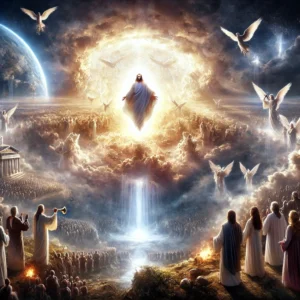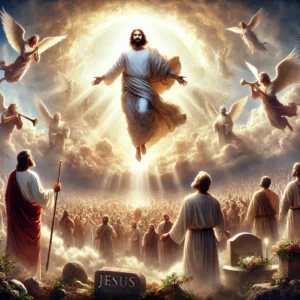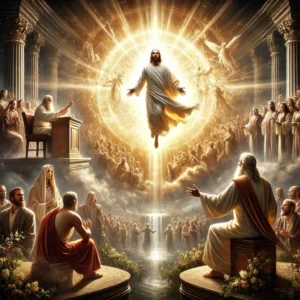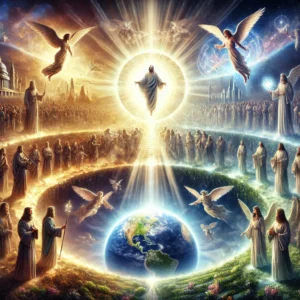
The Second Coming of Jesus, also known as the Parousia, is a central element of Christian eschatology—the study of end times. This prophesied return is believed to bring the fulfillment of God’s plan for the world, marking the final judgment, the establishment of God’s kingdom, and the ultimate defeat of evil. Throughout Christian history, various interpretations of this event have emerged, leading to different understandings of its timing, nature, and theological significance. Let’s explore the biblical prophecies regarding the Second Coming and the various interpretations that shape Christian views on this profound event.
Biblical Prophecies of the Second Coming

The Bible contains numerous references to the Second Coming of Christ, particularly in the New Testament. These prophecies emphasize the return of Jesus in power and glory, fulfilling his promises and bringing justice to the world. Key passages include:
- Matthew 24:30: “Then will appear the sign of the Son of Man in heaven. And then all the peoples of the earth will mourn when they see the Son of Man coming on the clouds of heaven, with power and great glory.”
- 1 Thessalonians 4:16-17: “For the Lord himself will come down from heaven, with a loud command, with the voice of the archangel and with the trumpet call of God, and the dead in Christ will rise first. After that, we who are still alive and are left will be caught up together with them in the clouds to meet the Lord in the air.”
- Revelation 19:11-16: Describes the return of Christ as a warrior king who defeats the forces of evil, bringing justice and peace to the world.
These passages depict the Second Coming as a cosmic event where Jesus returns visibly, triumphantly, and decisively to establish God’s kingdom and judge the world.
Theological Implications of the Second Coming

The Second Coming of Jesus carries profound theological implications for Christians. It represents the culmination of history and the fulfillment of God’s redemptive plan. Key theological themes include:
- Final Judgment: The Second Coming is associated with the final judgment, where all humanity will be judged based on their faith and deeds. Matthew 25:31-46 describes Jesus separating the righteous from the unrighteous, often symbolized as sheep and goats, determining their eternal destinies.
- Resurrection and Eternal Life: At the Second Coming, Christians believe that the dead will be resurrected and the faithful will receive eternal life. This hope is tied to the promise of a new creation, where death and suffering are no more (Revelation 21:1-4).
- The Defeat of Evil: The return of Jesus is also seen as the moment when all evil, including Satan and his forces, will be defeated (Revelation 20:10). This represents the final victory of God’s kingdom over all forms of injustice, sin, and death.
- The Kingdom of God: The Second Coming marks the full establishment of the Kingdom of God, where Jesus reigns as King. This kingdom is characterized by righteousness, peace, and justice, fulfilling the prophetic visions of the Old Testament (Isaiah 9:6-7).
Interpretations of the Second Coming

Over the centuries, Christians have developed different interpretations of how and when the Second Coming will take place. These interpretations are influenced by biblical prophecies, historical events, and theological perspectives. The three major views are:
1. Premillennialism
Premillennialism teaches that Jesus will return before a literal 1,000-year reign (the millennium) on earth, as described in Revelation 20:1-6. This view is divided into two main categories:
- Historic Premillennialism: This view holds that after a period of tribulation, Jesus will return to reign on earth for 1,000 years, during which time Satan will be bound. Following this reign, there will be a final rebellion, the defeat of evil, and the establishment of the new heaven and new earth.
- Dispensational Premillennialism: A more recent development within premillennialism, this view includes the concept of the Rapture, where believers will be taken up to meet Christ before the tribulation begins. After the Rapture, there will be a period of intense suffering on earth (the Great Tribulation), followed by Christ’s return to establish his millennial kingdom.
Premillennialism emphasizes a literal interpretation of the Bible, particularly regarding end-time events, and sees the Second Coming as occurring in two stages: the Rapture and the final return of Christ.
2. Postmillennialism
In Postmillennialism, the Second Coming of Christ occurs after the millennium, which is understood as a long period of peace and righteousness on earth. According to this view, through the spread of the gospel and the influence of the Church, the world will gradually become more just and godly, ushering in a golden age of Christian rule.
Once this millennium is complete, Jesus will return to judge the living and the dead and establish the eternal kingdom. Postmillennialism was particularly popular during the 18th and 19th centuries, especially during periods of optimism about human progress and the spread of Christianity.
3. Amillennialism
Amillennialism interprets the millennium symbolically rather than literally. In this view, the “millennium” is not a future event but rather represents the current reign of Christ in heaven and in the hearts of believers. This reign began with Jesus’ resurrection and continues until his return at the end of time.
Amillennialists believe that the Second Coming will coincide with the final judgment and the establishment of the new heaven and new earth. They reject the idea of a literal 1,000-year reign on earth and instead see the millennium as a spiritual reality that has been unfolding since the early Church.
Signs of the Second Coming
Many Christians believe that certain signs will precede the Second Coming of Jesus. These signs, drawn from both the Old and New Testaments, include:
- Wars and natural disasters (Matthew 24:6-7)
- Increased persecution of Christians (Matthew 24:9)
- The spread of the gospel to all nations (Matthew 24:14)
- The appearance of false prophets and messiahs (Matthew 24:24)
- The Great Tribulation—a time of unparalleled suffering and conflict (Revelation 7:14)
While many attempt to interpret current events as signs of the end times, the Bible also emphasizes that the exact time of Jesus’ return is unknown: “But about that day or hour no one knows, not even the angels in heaven, nor the Son, but only the Father” (Matthew 24:36).
The Role of the Second Coming in Christian Hope

The Second Coming of Jesus is central to Christian hope. It assures believers that despite the trials and injustices of this world, Christ will return to bring justice, peace, and eternal life. This belief shapes Christian life by encouraging perseverance, faithfulness, and a focus on living in alignment with God’s kingdom.
Christians are called to live in anticipation of Christ’s return, but also to engage in active discipleship, seeking justice, and spreading the gospel. The Second Coming serves as a reminder that human history is moving toward a divine resolution, where good triumphs over evil and God’s will is fully realized.
Conclusion
The Second Coming of Jesus represents the ultimate fulfillment of God’s redemptive plan, bringing hope, justice, and renewal to a broken world. While interpretations of the timing and nature of this event vary among Christians, the theological significance remains constant: Jesus will return to judge the living and the dead, establish his eternal kingdom, and bring peace to those who follow him. For believers, this promise is a source of hope, encouraging them to live faithfully as they await the return of the King of Kings.



